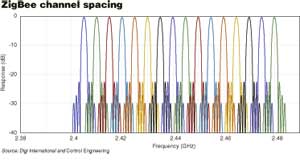A look at the differences between IEEE 802.15.4 and ZigBee.
Wireless networks are becoming more ubiquitous and are implemented using a variety of protocols specifically designed for radio frequency systems. Some protocols that are in use are proprietary to individual vendors while others are industry standards.
ONLINE Extra: link to more than 30 wireless resources控制工程网版权所有, below.
RecentlyCONTROL ENGINEERING China版权所有, a lot of attention has been given to 802.15.4 and ZigBee, but there is still some ambiguity as to what is di
What is IEEE 802.15.4?
IEEE 802.15.4 is a standard for wireless communication established by the Institute for Electrical and Electronics Engineers (IEEE). A few examples of wireless IEEE standards include the 802.11 standard which defines communication for wireless local area networks (LANs) and 802.16 that is used for broadband wireless communication in Metropolitan Area Networks.

At 2.4 GHz, communication occurs in one of sixteen 5 MHz channels ranging from 2.405 to 2.480 GHz.
This standard is designed specifically for communications in a point-to-point or a point-to-multipoint configuration with sleeping and security also being integral parts of the standard. A typical application involves a central coordinator that often acts as a data collector控制工程网版权所有, with multiple remote nodes connecting back to this central host. While both 802.11 and 802.16 standards are concerned with higher bandwidth Internet access applications控制工程网版权所有, 802.15.4 was developed with a lower data rate, simple connectivity, and battery-powered applications in mind. The 802.15.4 standard specifies that communication can occur in the 868.0-868.8 MHz, the 902-928 MHz or the 2.400-2.4835 GHz industrial scientific and medical (ISM) bands. The 868 MHz and 902 MHz bands offer the least amount of bandwidth under the specification控制工程网版权所有, with 20 kHz and 40 kHz available, respectively, for each channel. While any of thes


 在线会议
在线会议 论坛
论坛 专题
专题 工控直播
工控直播 新闻中心
新闻中心 子站
子站 技术
技术 社区
社区


 2025 (第十四届) 全球自动化和制造主题峰会 ·深圳站
2025 (第十四届) 全球自动化和制造主题峰会 ·深圳站 2025 Raythink燧石红外热像仪有奖试用
2025 Raythink燧石红外热像仪有奖试用.jpg) 立即获取Fluke在线红外热像仪解决方案白皮书
立即获取Fluke在线红外热像仪解决方案白皮书 2025电子及半导体智能制造创新高峰论坛
2025电子及半导体智能制造创新高峰论坛.jpg) 电机与变频驱动故障排除白皮书免费下载
电机与变频驱动故障排除白皮书免费下载




























